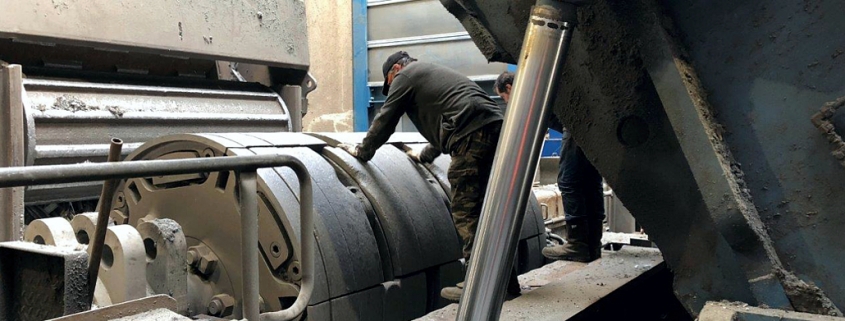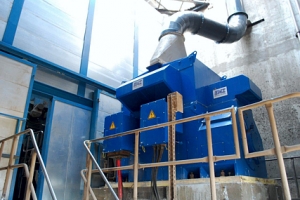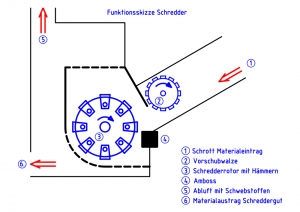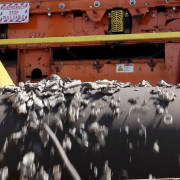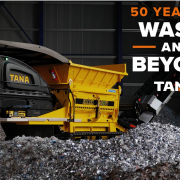Powerful Drive for Recycling: EMZ Modernizes Shredder Plant for Metal Scrap with Special Motor
Metal recycling is one of the most important raw materials sources in Europe. Specifically shredder plants at scrap yards that shred whole cars, white goods or metal profiles are operating in this field. They ultimately prepare these parts for further processing. Availability and a good performance are decisive factors: Decons SAS, a successful and privately run recycling company from the Gironde department in southwest France, has now modernised the drive solution of an existing shredder together with EMZ from Recklinghausen.
The classic scrap yards of the past have now given way to highly efficient recycling parks. Nowadays, they produce metal fractions in large quantities and with high purity. The main customers are steelworks and smelters specialising in individual metals. Underlying this form of recycling is the fact that elementary metals and alloys do not dissipate when being used. They are, therefore, available again at the end of a product life cycle – provided they find their way into recycling at scrap yards. Typical processing steps are pressing, cutting, and shredding in shredder plants with a power supply capacity in the megawatt range.
“The operating principle corresponds to a rotating hammer mill whose cylinders have movable hammers which are mounted along an axis,” explains Benedikt Mathiaszyk, who is the Managing Director of Elektro-Maschinen-Zentrale GmbH in Recklinghausen and also responsible for large drives and projects. When the rotor rotates, the hammers move outwards by centrifugal force and shatter the scrap metal that is supplied by the feed rollers into small pieces. Since the loads are so heavy, the hammers – despite being manufactured from a special alloy – only achieve a service life of two days per side. After four days, the hammers with a unit weight of around 135 kilograms have to be completely replaced. “However, they process several thousand tons of scrap in their relatively short operation time.”
Improved thermal performance with new motor
After a comprehensive modernization of this plant, the rotor of the shredder, which weighs more than 40 tons, is today driven by a ten-pole EMZ slip ring motor. At the Decons recycling site in Le Pian Medoc near the southern French city of Bordeaux, this motor delivers a rated output of 4000 HP – i.e., just below 3000 kW. The main reasons for the reconstruction of the drive were serious thermal problems with the existing original engine. The drive was simply too small for the shredder plant, became too hot and thus had to cool down again and again due to the overload – which could ultimately only be achieved by reducing the material feed and consequently throttling production.
The new motor from the EMZ ASD series, which was specially developed for shredder applications, now provides more reserves with a rated output of almost 3000 kW. According to Benedikt Mathiaszyk, the machine could also be operated with 3500 kW thanks to the optimized thermal characteristics. For this project, the high torque volume density paved the way for mounting the more powerful motor on the foundation of the existing drive without costly modifications. The coupling connection between the engine shaft and cardan shaft was similarly easy – at least as far as the existing installation dimensions were concerned.
On the contrary, the design of the mechanical power transmission by EMZ was much more demanding. The shredder motor is directly coupled to the shredder rotor via a cardan shaft. This construction is necessary because the complete shredder is flexibly mounted on strong steel springs, while the shredder motor is grounded on a rigid and solid concrete foundation. Calculations by the cardan shaft manufacturer have revealed torque shocks of up to 500 kNm prior to the retrofitting, which in turn can cause axial shock stressings of up to 60 tons.
Full power, even when the going gets tough
The fast and hard torque shocks have an effect on the high-voltage motor. Thus, the entire design is constructed to withstand high vibrations: The motor is vibrationresistant up to a maximum vibration value of 28 mm/s. The comparison with a vibration motor is absolutely accurate, since EMZ had to reinforce the special design of the housing, the shaft, the electrical active parts, as well as the carbon brushes, bearings, and slip rings in order to make the entire construction as robust as possible. All adjustments were made under the premise of delivering the the motor with its full power potential and high availability, but without derating. “Everything about this engine is special,” concludes Benedikt Mathiaszyk, speaking of the close cooperation with the cardan shaft manufacturer. According to the managing director, the company was just as surprised by the amount of determined torque values as the manufacturer of the shredder.
The parameters have ultimately been incorporated into an optimized shaft design with an oil press bandage instead of a feather key, which typically quickly deflects during impact loads, and thus creates play. When using the oil press bandage, the coupling half is shrunk onto the shaft end with a press fit and consequently forms a friction-locked connection. “Thanks to the high static friction, we almost achieve the strength of a welded connection,” says the managing director. The coupling half is then removed during maintenance or repairs by creating an oil pressure through an oil groove in the shaft.
Another measure that makes the EMZ slip-ring motor so trend-setting for the use in shredder application is the control of load behaviour. The drive in the plant of the French recycling company works with a fixed load speed of 595 rpm at a voltage of 5500V and a frequency of 50Hz because it is rigidly operated on the mains supply. Given the high moment of impact of the shredder rotor, weighing more than 40 tons, and the resulting current peaks, EMZ was faced with the task of effectively limiting the load currents. Here, the company from Recklinghausen relies on a precise, safe, and low-maintenance technology: the liquid starter. MKS is a specialist in this field. The company from Jülich was also closely involved in the project – with the aim of “jointly offering the best technical solution for the task”, says EMZ Managing Director Stefan Beese retrospectively.
The liquid starter has the task of reducing the speed of the motor in a targeted manner in the event of a load surge, e.g., when the hammers are confronted with harder scrap or when scrap fractions of varying density need to be processed. If the current rises above a limit value, a servomotor immediately increases the contact distances between the electrodes in the liquid starter. Then, the increase of the ohmic resistance in the rotor circuit leads to a controlled speed reduction of the motor and the shredder rotor. This allows the kinetic energy of the rotating system to be used to compensate for the load surge.
Hence, this design compensates for network perturbations and further harmonises current consumption during changing loads. In this context, EMZ uses the liquid starter from MKS for controlling the feed roll. “If the nominal current value of the motor is reached, the roll stops, once the value decreases again, the material is conveyed again”, explains Benedikt Mathiaszyk.
Production increased by half
In practice, the outlined structure works so well that the recycling company in southern France had to adapt the upstream and downstream logistics processes after modernising the shredder plant. Depending on the materials, the operator speaks of productivity increases of up to 50 percent without the engine reaching its thermal limits. The higher output also affects the quality of the shredder material. Steffen Kollack, Technical Manager of Decons SAS, is very satisfied with the performance of the new shredder motor: “We feed the material faster, thus increasing the volume in the shredder and obtaining finer grains and better qualities because the metal pieces can work each other off. If we could previously calculate a weight of six tons with a full wheel loader bucket, then today we have to calculate a weight of eight tons due to the higher bulk density.”
Source: EMZ Elektro-Maschinen-Zentrale GmbH

